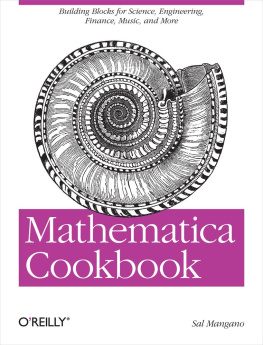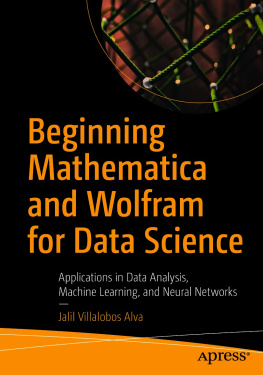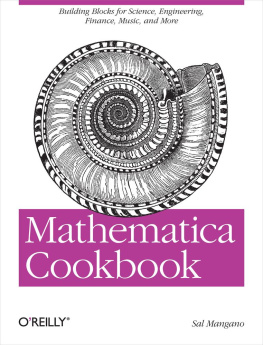Sal Mangano - Mathematica Cookbook
Here you can read online Sal Mangano - Mathematica Cookbook full text of the book (entire story) in english for free. Download pdf and epub, get meaning, cover and reviews about this ebook. year: 2010, publisher: OReilly Media, genre: Home and family. Description of the work, (preface) as well as reviews are available. Best literature library LitArk.com created for fans of good reading and offers a wide selection of genres:
Romance novel
Science fiction
Adventure
Detective
Science
History
Home and family
Prose
Art
Politics
Computer
Non-fiction
Religion
Business
Children
Humor
Choose a favorite category and find really read worthwhile books. Enjoy immersion in the world of imagination, feel the emotions of the characters or learn something new for yourself, make an fascinating discovery.
- Book:Mathematica Cookbook
- Author:
- Publisher:OReilly Media
- Genre:
- Year:2010
- Rating:4 / 5
- Favourites:Add to favourites
- Your mark:
Mathematica Cookbook: summary, description and annotation
We offer to read an annotation, description, summary or preface (depends on what the author of the book "Mathematica Cookbook" wrote himself). If you haven't found the necessary information about the book — write in the comments, we will try to find it.
Mathematica Cookbook helps you master the applications core principles by walking you through real-world problems. Ideal for browsing, this book includes recipes for working with numerics, data structures, algebraic equations, calculus, and statistics. Youll also venture into exotic territory with recipes for data visualization using 2D and 3D graphic tools, image processing, and music.
Although Mathematica 7 is a highly advanced computational platform, the recipes in this book make it accessible to everyone -- whether youre working on high school algebra, simple graphs, PhD-level computation, financial analysis, or advanced engineering models.
- Learn how to use Mathematica at a higher level with functional programming and pattern matching
- Delve into the rich library of functions for string and structured text manipulation
- Learn how to apply the tools to physics and engineering problems
- Draw on Mathematicas access to physics, chemistry, and biology data
- Get techniques for solving equations in computational finance
- Learn how to use Mathematica for sophisticated image processing
- Process music and audio as musical notes, analog waveforms, or digital sound samples
Sal Mangano: author's other books
Who wrote Mathematica Cookbook? Find out the surname, the name of the author of the book and a list of all author's works by series.







